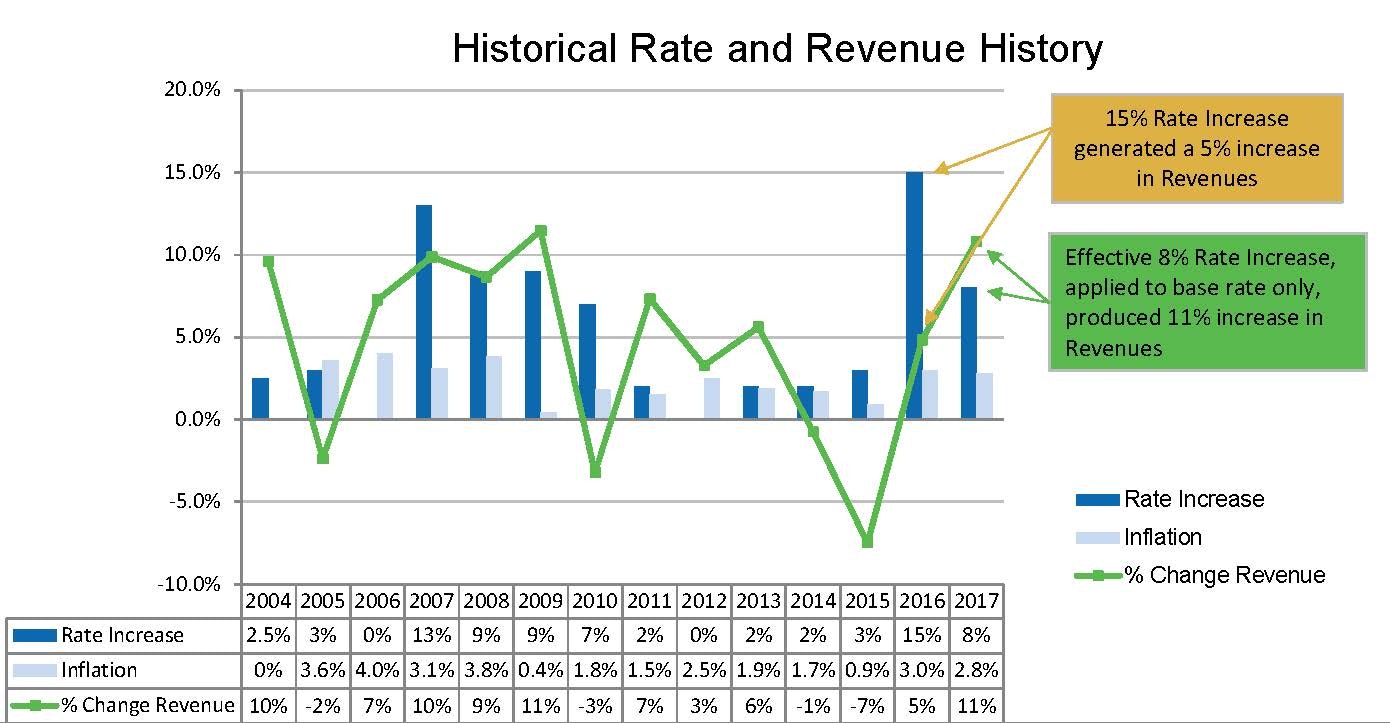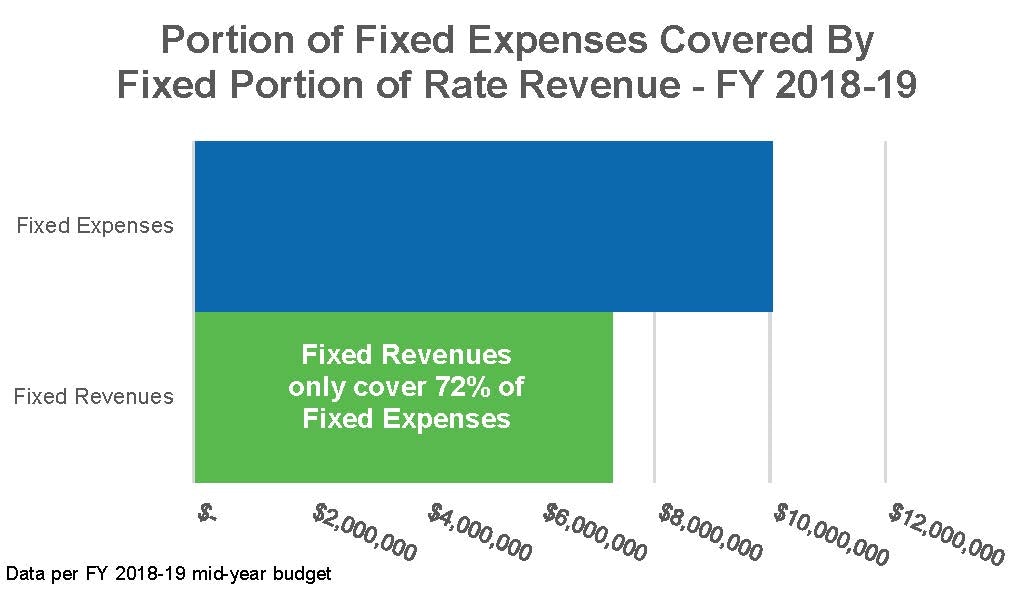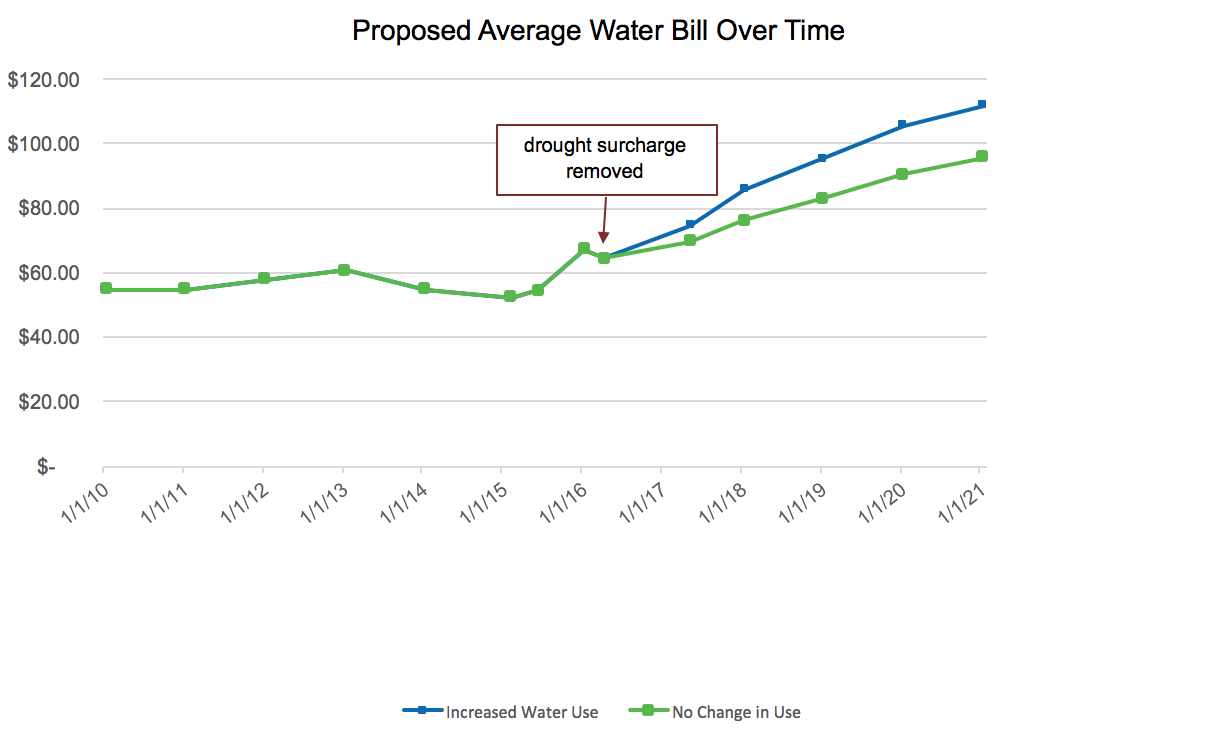Water Rates FAQs
How are the rates calculated?
The water rates include a daily fixed charge and a water usage charge. The daily fixed charge is based on the size of each customer’s water meter and is intended to recover a proportionate share of the fixed costs associated with operating and maintaining the system. The usage charge is based on a uniform water usage rate multiplied by each customer’s water usage. Usage charge revenue is intended to cover variable costs such as water supply, treatment, and pumping costs.
The District is legally prohibited from charging more than the actual cost of providing water service (which includes covering all fixed costs and accrual of a prudent reserve for future replacements, upgrades and repairs) to our customers.
Why did San Juan put a drought surcharge into effect and what is the status?
San Juan initiated a drought surcharge in April 2015 to cover a portion of the lost revenue due to decreased water sales associated with the state's conservation mandates. On March 23, 2016, the San Juan Board of Directors approved moving from a Stage 4 Water Crisis Conservation level back to a Stage 2 Water Alert Conservation level with a voluntary 10 percent use reduction. By moving to Stage 2 from Stage 4, the 10 percent drought surcharge was removed April 1, 2016.
How do San Juan Retail rates compare with other agencies?
Please click here to see a comparison of water bills for typical monthly usage rates in San Juan, compared to other urban communities in various parts of California.
How do San Juan Wholesale water rates compare to other agencies?
San Juan Wholesale water rates are some of the lowest in the State of California. Please see the graph for more information.
San Juan Retail has raised its rates over the last few years. Why does the District still need more money?
All water agencies and city water utilities, including San Juan Retail, receive the majority of their income from water sales and property-related fees, please see Retail Revenue Sources for the San Juan Water District:
Because of drought-related water conservation and actions by our Board to limit water rate increases, San Juan’s income fell dramatically during the drought, to levels insufficient to fully fund operations and ensure adequate funding for pipeline and facility repairs and replacements.
San Juan’s experience is not unique. Other water agencies in the Sacramento region and throughout the state are experiencing similar revenue shortfalls. San Juan Retail’s rate increases are designed to provide the revenue necessary to operate your water supply system with the lowest possible impact on your budgets.
There are many other reasons why San Juan’s Retail water rates have increased over the years, including:
- The cost for buying and treating water in San Juan’s Wholesale operations has risen over time (due in part to infrastructure repair and replacement at Folsom reservoir)
- Keeping up with changes in federal and state regulatory requirements that ensure your water is safe
- Increased healthcare costs and other employee benefits as well as cost of living salary adjustments for the 27.9 San Juan Retail staff members.
- Repayment of $14 million in funds that have been borrowed to fund infrastructure improvements
- Cost increases to maintain an aging system (most of San Juan’s facilities are over 50 years old)
To avoid rate increases after the 2008 recession, San Juan delayed maintaining and replacing pipelines, pumping and storage facilities, service vehicles and other equipment and drew upon financial reserves to pay for operations. These reserves were almost depleted, and additional revenue has been needed to be able to maintain operations and a small reserve in case of future economic downturns.
This has been a short-term solution, and creates significant risk if we continue to delay repairing and replacing your water system infrastructure. A large part of the proposed rate increases include funding to maintain this infrastructure. A good example of these types of projects is Hinkle Reservoir, a 62 million gallon covered reservoir that stores the water treated at our treatment plant. The lining and cover for Hinkle Reservoir, were constructed in 1981 and had an estimated life of 20 years. Through good maintenance and a dash of good luck, the cover and liner have far outlasted their expected life. Recent stress tests show that the cover and lining are now in need in replacement, at an estimated cost of $23.8 million. While the District does have a reserve fund dedicated to this project, because rates have been held so low, for so long, the balance in the reserve isn’t close to covering the cost and the District will have to incur debt to finance the project.
While deferring projects and keeping rates low has short term benefits, in the long run they cost more money. What starts as a small maintenance item, if left unaddressed, can turn into a major rehabilitation project. Delaying rate increases, and not building adequate reserves leads to the need for debt to finance critical projects, such as the Hinkle Reservoir. Debt is expensive. San Juan’s Board of Directors wants to minimize debt for infrastructure maintenance and replacement projects for pipelines and facilities. They are committed to building and maintaining adequate reserve funds as part of best practices.
Below is an overview of San Juan Retail’s rate increases during the last five years.
2018 – effective 9% increase
2017 – effective 8% increase
2016 – 15% (drought surcharge removed April 1, 2016)
2015 – 3% (and temporary drought surcharge of 10%)
2014 – 2%
Inflation is one driver of rate increases. See the ten year history (below) of rate increases adjusted for inflation. The chart indicates that there were no rate increases in 4 of the last 10 years, and two of those 4 years were actually rate reductions, relative to inflation.
Why am I paying more for using less?
During the 2013-15 drought, the State Water Resources Control Board mandated a 36% decrease in water use by San Juan and its customers. San Juan’s customers responded, and decreased use even further than the state mandated. To help mitigate the significant reductions in revenues, San Juan imposed a short-term drought surcharge, which was rescinded in 2016. While rates went up, customers ended up paying lower water bills, due to their reduction in water use.
Since 2016, water use has increased slightly, but has not returned to pre-drought levels. Depending on the amount of water a customer uses, their water bill may still be lower than the level prior to the drought. Most water agencies in the State of California set up their rates to encourage people to save water, meaning most of the rate was based upon how much water you use, the more you use, the more you pay. The problem with this model is that the largest part of our expenses are fixed, and don’t change based upon the amount of water we deliver. We must staff and operate our treatment plant 24 hours per day, 7 days per week, no matter how much water we deliver. Similarly, we must fix leaks, read meters and answer your calls. Conservation by our customers allows us to comply with state mandates, address droughts and saves customers money, but it reduces our ability to fund the operation of your water supply system. The result is that you feel punished by rate increases when you conserve, because your bills didn’t generate enough revenue to operate the system. The District’s past rate increases have not generated the same level of increased revenue as clearly shown in this chart:

In the 2017-21 rate structure, the District is keeping the water use portion of the rate constant over the five year period, and increasing the daily base rate so that a larger portion of your payment will not fluctuate with your use. This will decrease the need for future large rate increases when water use falls. This chart illustrates the disconnect between fixed costs and fixed rate revenue from your Daily Base Charge.

2017-21 Rate Plan
What is included in the rate plan?
San Juan Retail mailed a Proposition 218 notice to all retail customers on February 6, 2017 proposing a five-year rate plan - see the Proposition 218 notice.
The 2017 increase became effective May 2017, and in each subsequent year, rate changes become effective in January. The rate changes apply only to the daily base rate, the water use charge remains unchanged. The daily base rate is increasing from $1.24 to $2.29 by January 2021. While this rate increase approximates an 85% increase, your actual water bill will NOT increase by this percentage change, since the daily base rate is only one component of your bill and the other component, the water usage charge, is NOT changing.
See the Annual Overall (effective) Water Rate Increases:

See how an average water user's bill has changed over time and is projected to change with the new rates:

